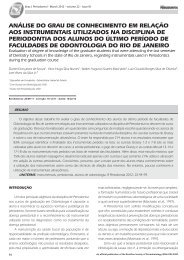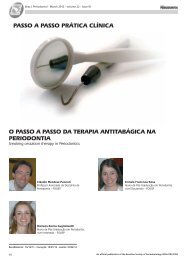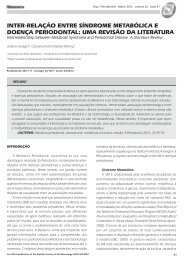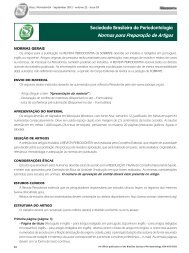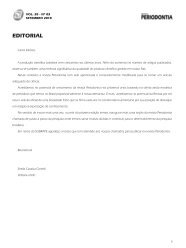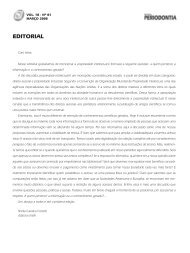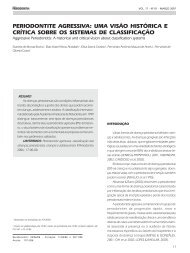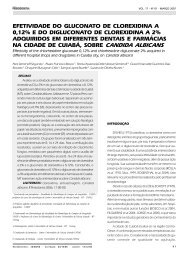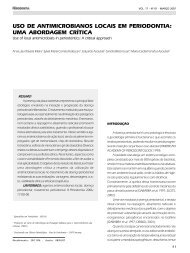o papel da clorexidina no tratamento de ... - Revista Sobrape
o papel da clorexidina no tratamento de ... - Revista Sobrape
o papel da clorexidina no tratamento de ... - Revista Sobrape
You also want an ePaper? Increase the reach of your titles
YUMPU automatically turns print PDFs into web optimized ePapers that Google loves.
R. Periodontia - Dezembro 2007 - Volume 17 - Número 04<br />
O PAPEL DA CLOREXIDINA NO TRATAMENTO DE<br />
PACIENTES COM GENGIVITE NO DISTRITO DE SÃO<br />
CARLOS DO JAMARI - RO<br />
The role of chlorexidine on the treatment of patients with gingivitis in Sao Carlos’ district – RO<br />
Bru<strong>no</strong> S Herrera 1 , Gerusa IAC Men<strong>de</strong>s 2 , Rodrigo M Porto 1 , Hamilton M Rigato 3 , Leonard D Moreira 4 , , Marcelo N Muscará 5 , José C<br />
A Magalhães 6 , Gustavo D Men<strong>de</strong>s 7<br />
RESUMO<br />
A principal causa <strong>da</strong> gengivite é o acúmulo <strong>de</strong> placa<br />
bacteriana que po<strong>de</strong> ser evita<strong>da</strong> com a utilização <strong>de</strong> meios<br />
preventivos mecânicos e químicos. A <strong>clorexidina</strong> é um agente<br />
químico <strong>de</strong> amplo espectro antibacteria<strong>no</strong>. O objetivo do estudo<br />
foi a avaliação dos efeitos clínicos <strong>da</strong> <strong>clorexidina</strong> na saú<strong>de</strong><br />
gengival, por meio <strong>de</strong> sua ação antibacteriana <strong>no</strong> controle <strong>da</strong><br />
gengivite, em pacientes que apresentam pouca higienização<br />
<strong>da</strong> cavi<strong>da</strong><strong>de</strong> bucal <strong>no</strong> Distrito <strong>de</strong> São Carlos - Porto Velho – RO.<br />
Através do Projeto NAPRA (Núcleo <strong>de</strong> Apoio a População Ribeirinha<br />
<strong>da</strong> Amazônia) foram selecionados 15 voluntários com<br />
gengivite, que foram divididos em grupo controle (cinco voluntários)<br />
e grupo <strong>clorexidina</strong> (10 voluntários). Para o grupo<br />
<strong>clorexidina</strong> foi administrado fármaco a base <strong>de</strong> <strong>clorexidina</strong><br />
(Periogard ® Colgate) e ao grupo controle foi administrado<br />
placebo (água). Os grupos foram monitorados a ca<strong>da</strong> cinco<br />
dias, através <strong>de</strong> exames físicos e Índice Gengival <strong>de</strong> Löe, durante<br />
um período <strong>de</strong> 15 dias. Antes do início do estudo, tanto o<br />
grupo estudo como o grupo controle encontravam-se equilibrados<br />
estatisticamente quanto à média <strong>de</strong> Índice Gengival <strong>de</strong><br />
Löe. Foi observado que o uso <strong>de</strong> <strong>clorexidina</strong> por um periodo <strong>de</strong><br />
10 dias reduziu e controlou significantemente a gengivite em<br />
pacientes que apresentavam higiene bucal <strong>de</strong>ficiente, através<br />
<strong>de</strong> sua ação antibacteriana.<br />
UNITERMOS: Clorexidina, Gengivite, Índice Gengival <strong>de</strong><br />
Löe. R Periodontia 2007; 17:60-64.<br />
1<br />
Doutorando em Farmacologia, ICB, USP-SP<br />
2<br />
Cirurgiã-<strong>de</strong>ntista<br />
3<br />
Mestre em Farmacologia – UNICAMP<br />
4<br />
Mestrando em Clinica Medica – FCM, UNICAMP<br />
5<br />
Professor Livre-docente do <strong>de</strong>partamento <strong>de</strong> Farmacologia, ICB, USP-SP<br />
6<br />
Coor<strong>de</strong>nador <strong>da</strong> Facul<strong>da</strong><strong>de</strong> <strong>de</strong> Odontologia – UNICASTELO<br />
7<br />
Doutor em Fisiopatologia - UNICAMP<br />
Recebimento: 22/12/06 - Correção: 21/03/07 - Aceite: 11/05/07<br />
INTRODUÇÃO<br />
A principal causa <strong>da</strong> gengivite é o acúmulo <strong>de</strong> placa<br />
bacteriana que po<strong>de</strong> ser evita<strong>da</strong> com a utilização <strong>de</strong><br />
meios preventivos mecânicos, como a escovação e<br />
químicos (Denardi, 1994; Feist et al, 1998).<br />
A <strong>clorexidina</strong> é um agente químico <strong>de</strong> amplo<br />
espectro antibacteria<strong>no</strong>, utiliza<strong>da</strong> para a manutenção<br />
<strong>da</strong> saú<strong>de</strong> gengival e <strong>tratamento</strong> <strong>da</strong> gengivite (Denardi,<br />
1994; Feist et al, 1998; Boobis, 1991). Foi <strong>de</strong>senvolvi<strong>da</strong><br />
<strong>no</strong> final dos a<strong>no</strong>s 40 pela ICI (Imperial Chemical<br />
Industries; Londres, Grã-bretanha; Zanatto, 1996;<br />
Sekiguchi et Al., 2006). Seus efeitos foram <strong>de</strong>scritos,<br />
primeiramente, em 1954 como antimalárico, sendo<br />
utiliza<strong>da</strong> como inibidor <strong>de</strong> placa <strong>de</strong>ntal somente em<br />
1970 (Löe & Schiott, 1970).<br />
A <strong>clorexidina</strong> é um antiséptico catiônico que age<br />
contra uma ampla varie<strong>da</strong><strong>de</strong> <strong>de</strong> bactérias, fungos e<br />
alguns vírus lipofílicos (Denton et al, 1991). Seu efeito<br />
antibacteria<strong>no</strong> se dá com a interação não-específica com<br />
o ácido fosfolipídico <strong>da</strong> membrana celular que causa<br />
alterações na permeabili<strong>da</strong><strong>de</strong> <strong>da</strong> membrana para íons,<br />
como potássio, e para constituintes do citosol como<br />
ami<strong>no</strong>ácidos e nucleotí<strong>de</strong>os. Em altas concentrações, a<br />
ativi<strong>da</strong><strong>de</strong> <strong>de</strong> enzimas associa<strong>da</strong> a membrana, como<br />
<strong>de</strong>hidrogenases e ATPase, é indiretamente afeta<strong>da</strong><br />
(Davies, 1973; Brecx & Theila<strong>de</strong>, 1984). Esse fármaco<br />
60<br />
rev<strong>de</strong>zrepaginado30-04indmexido.pmd 60<br />
27/5/2008, 18:48
R. Periodontia - 17(3):60-64<br />
causa diferentes efeitos <strong>de</strong>pen<strong>de</strong>ndo <strong>da</strong> sua concentração:<br />
bacteriostático em baixas concentrações e bacterici<strong>da</strong> em<br />
altas concentrações. A ativi<strong>da</strong><strong>de</strong> bacteriostática e bacterici<strong>da</strong> <strong>da</strong><br />
<strong>clorexidina</strong> é reduzi<strong>da</strong> na presença <strong>de</strong> altas concentrações <strong>de</strong><br />
soro, proteína, sangue e outros compostos orgânicos (Boobis,<br />
1991).<br />
Não há evidência <strong>de</strong> carci<strong>no</strong>genici<strong>da</strong><strong>de</strong> em testes realizados<br />
por 18 meses em ratos e cães, bem como não há evidência <strong>de</strong><br />
efeito teratogênico em ratos e coelhos. Nenhum efeito foi<br />
observado em homens após doses orais diárias <strong>de</strong> 2 gramas por<br />
uma semana; ou em ratos e macacos, após o uso <strong>de</strong> uma<br />
solução <strong>de</strong> 0,05% <strong>de</strong> <strong>clorexidina</strong> administra<strong>da</strong> com água por<br />
um período <strong>de</strong> seis meses (Boobis, 1991; Kornman, 1986).<br />
Quando absorvi<strong>da</strong>, a <strong>clorexidina</strong> é metaboliza<strong>da</strong> <strong>no</strong> fígado<br />
rapi<strong>da</strong>mente, sendo excreta<strong>da</strong> nas fezes através <strong>da</strong> bile. Em<br />
um estudo com ratos, 20% <strong>da</strong> dose <strong>de</strong> <strong>clorexidina</strong> marca<strong>da</strong><br />
foi encontra<strong>da</strong> <strong>no</strong>s animais até cinco dias <strong>de</strong>pois <strong>de</strong> seu uso<br />
(Bobbis, 1991).<br />
Uso terapêutico<br />
Em uma concentração <strong>de</strong> 4%, a <strong>clorexidina</strong> é utiliza<strong>da</strong> para<br />
a <strong>de</strong>sinfecção pré-operatória <strong>da</strong>s mãos e por não apresentar<br />
absorção cutânea po<strong>de</strong> ser usa<strong>da</strong> diariamente (Boobis, 1991). A<br />
imersão por 30 minutos em solução <strong>de</strong> <strong>clorexidina</strong> (0,05%) é<br />
utiliza<strong>da</strong> para a <strong>de</strong>sinfecção <strong>de</strong> instrumentais limpos.<br />
É utiliza<strong>da</strong> também para combater o aumento <strong>da</strong> placa<br />
bacteriana e alterações <strong>da</strong> microbiota gera<strong>da</strong> pela dificul<strong>da</strong><strong>de</strong> <strong>de</strong><br />
higienização <strong>de</strong>vido à presença do aparelho ortodontico (Zanatto,<br />
1996) e em pacientes com alto risco à cárie causado por outros<br />
motivos (Brauner, 1982; Navarro & Côrtes, 1995). Verniz/selante<br />
à base <strong>de</strong> clorexedina/poliureta<strong>no</strong> são eficazes na supressão e/<br />
ou eliminação <strong>de</strong> Streptococcus mutans <strong>da</strong> superfície <strong>de</strong>ntal.<br />
Essa eliminação po<strong>de</strong> reduzir o <strong>de</strong>senvolvimento <strong>da</strong> doença cárie<br />
principalmente <strong>no</strong>s primeiros quatro meses após a aplicação do<br />
verniz, sendo eficaz em um período <strong>de</strong> dois a<strong>no</strong>s (Bretz, 1995;<br />
Zhang, 2006). O uso do poliureta<strong>no</strong> <strong>no</strong> contato do verniz <strong>de</strong><br />
<strong>clorexidina</strong> com as superfícies <strong>de</strong> mucosa, língua e <strong>de</strong>ntes, é<br />
necessário para evitar manchas <strong>no</strong>s <strong>de</strong>ntes e alterações <strong>de</strong> pala<strong>da</strong>r<br />
(Bretz, 1995). O uso <strong>da</strong> <strong>clorexidina</strong> sob a forma <strong>de</strong> <strong>de</strong>ntifrícios<br />
tem ativi<strong>da</strong><strong>de</strong> reduzi<strong>da</strong>, uma vez que há competição ou<br />
inativação pelos sítios <strong>de</strong> retenção entre íons cálcio e os<br />
<strong>de</strong>tergentes aniônicos presentes em suas formulações (Denardi,<br />
1994).<br />
Além <strong>de</strong> ser usa<strong>da</strong> <strong>no</strong> combate à doença cárie, a <strong>clorexidina</strong><br />
é utiliza<strong>da</strong> durante a fase <strong>de</strong> cicatrização após cirurgias<br />
periodontais e orais; para a prevenção <strong>de</strong> bacteremias póscirúrgicas<br />
(antes <strong>de</strong> procedimentos orais ou periodontais), em<br />
pacientes que apresentam dificul<strong>da</strong><strong>de</strong> <strong>de</strong> convencional<br />
higienização; para prolongamento do intervalo <strong>da</strong>s consultas<br />
periodontais; implantes <strong>de</strong>ntais; próteses extensas fixas e <strong>de</strong><br />
fixação intermaxilar (Denardi, 1994; Feist et al, 1998; Zanatto,<br />
1996) e em terapia médica <strong>de</strong> condições especiais como HIV<br />
(Denardi, 1994; Feist et al, 1998; Reddy, 2007). Concentrações<br />
<strong>de</strong> 0.12% po<strong>de</strong> ser emprega<strong>da</strong> duas vezes ao dia para o<br />
<strong>tratamento</strong> <strong>de</strong> gengivites, estomatite, tonsilite, faringites e<br />
infecções me<strong>no</strong>res <strong>de</strong> boca e garganta (Denardi, 1994; Feist et<br />
al, 1998).<br />
O objetivo <strong>de</strong>ste estudo é verificar os efeitos clínicos <strong>da</strong><br />
<strong>clorexidina</strong> <strong>no</strong> controle <strong>da</strong> gengivite por meio <strong>de</strong> sua ação<br />
antibacteriana em pacientes do Distrito <strong>de</strong> São Carlos - Porto<br />
Velho – RO, que apresentam pouca higienização <strong>da</strong> cavi<strong>da</strong><strong>de</strong><br />
bucal.<br />
MATERIAIS E MÉTODOS<br />
O estudo foi realizado em pacientes proce<strong>de</strong>ntes do Núcleo<br />
<strong>de</strong> Apoio à População Ribeirinha <strong>da</strong> Amazônia (NAPRA) <strong>no</strong> Distrito<br />
<strong>de</strong> São Carlos – Porto Velho – RO.<br />
Foram selecionados 15 voluntários com gengivite <strong>de</strong> faixas<br />
etárias <strong>de</strong> 6 a 18 a<strong>no</strong>s, que foram selecionados na Escola<br />
Henrique Dias (Distrito <strong>de</strong> São Carlos – Porto Velho – RO) através<br />
<strong>de</strong> uma anamnese que incluía o Índice Gengival <strong>de</strong> Löe para<br />
po<strong>de</strong>r triar os estu<strong>da</strong>ntes e selecionar 15 para o estudo. Os<br />
grupos foram divididos em Grupo Controle (cinco voluntários) e<br />
Grupo Clorexidina (<strong>de</strong>z voluntários). Após a seleção, os pacientes<br />
recebiam explicações sobre as causas do sangramento gengival,<br />
meios <strong>de</strong> evitar a gengivite, bem sobre a pesquisa <strong>da</strong> qual estariam<br />
participando. Primeiramente, o protocolo foi aprovado<br />
pela comissão <strong>de</strong> ética <strong>da</strong> Universi<strong>da</strong><strong>de</strong> São Francisco e todos<br />
os voluntários assinaram um termo <strong>de</strong> consentimento para o<br />
estudo.<br />
Para o grupo <strong>clorexidina</strong> foi administrado fármaco à base <strong>de</strong><br />
<strong>clorexidina</strong> 0,12% (Periogard ® Colgate) e a orientação foi feita<br />
seguindo a bula do fabricante, o Grupo Controle foi administrado<br />
placebo (água). Em ambos os grupos, as soluções foram<br />
administra<strong>da</strong>s (bochecho) pela manhã e à <strong>no</strong>ite, <strong>de</strong>pois <strong>da</strong> higiene<br />
bucal tradicional. Os pais dos pacientes foram instruídos a<br />
monitorar seus filhos durante o uso <strong>da</strong> solução <strong>de</strong> <strong>clorexidina</strong>.<br />
Nesse primeiro momento, os pacientes não receberam nenhuma<br />
orientação <strong>de</strong> higiene.<br />
Os grupos foram monitorados antes do estudo e a ca<strong>da</strong> 5<br />
dias com exames fisicos e Índice Gengival <strong>de</strong> Löe (Bretz, 1995),<br />
durante um período <strong>de</strong> 15 dias.<br />
O Índice Gengival <strong>de</strong> Löe (0 = gengiva <strong>no</strong>rmal; 1 =<br />
inflamação leve, sem sangramento à son<strong>da</strong>gem; 2 = inflamação<br />
mo<strong>de</strong>ra<strong>da</strong>, com sangramento à son<strong>da</strong>gem; 3 = inflamação<br />
grave, tendência ao sangramento espontâneo) foi realizado com<br />
son<strong>da</strong> periodontal para PSR (Golgran ® ) em quatros sítios por<br />
61<br />
rev<strong>de</strong>zrepaginado30-04indmexido.pmd 61<br />
27/5/2008, 18:48
R. Periodontia - 17(3):60-64<br />
<strong>de</strong>nte (mésio-vestibular, disto-vestibular, mésio-lingual e distolingual).<br />
A soma dos valores encontrados <strong>no</strong>s sítios dividido por<br />
quatro (número <strong>de</strong> sítios) resultou <strong>no</strong> índice gengival para o <strong>de</strong>nte.<br />
A soma dos índices gengivais <strong>de</strong> ca<strong>da</strong> <strong>de</strong>nte, dividido pelo número<br />
<strong>de</strong> <strong>de</strong>ntes examinados, resultou <strong>no</strong> índice gengival por pessoa.<br />
Os resultados do Índice Gengival <strong>de</strong> Löe foram registrados<br />
em fichas clínicas <strong>de</strong> ca<strong>da</strong> voluntário.<br />
To<strong>da</strong>s as informações obti<strong>da</strong>s durante a condução do estudo<br />
referentes ao estado do voluntário foram forneci<strong>da</strong>s ao corpo<br />
clínico <strong>da</strong> Clínica Odontológica <strong>da</strong> Facul<strong>da</strong><strong>de</strong> <strong>de</strong> Odontologia <strong>da</strong><br />
Universi<strong>da</strong><strong>de</strong> São Francisco.<br />
Todos os <strong>da</strong>dos são mostrados como média±S.D..<br />
Diferenças entre os grupos foram analisados usando o teste <strong>de</strong><br />
Stu<strong>de</strong>nt-Neuman-Keuls. Valores <strong>de</strong> probabili<strong>da</strong><strong>de</strong> me<strong>no</strong>res <strong>de</strong><br />
5% (p
R. Periodontia - 17(3):60-64<br />
Alguns pacientes tiveram seu primeiro contato com o<br />
cirurgião-<strong>de</strong>ntista através <strong>de</strong>sse protocolo clínico.<br />
CONCLUSÃO<br />
A <strong>clorexidina</strong>, utiliza<strong>da</strong> por um período <strong>de</strong> 10 dias, reduziu e<br />
controlou, significativamente, a gengivite <strong>de</strong> pacientes que<br />
apresentam pouca higienização <strong>da</strong> cavi<strong>da</strong><strong>de</strong> bucal, através <strong>da</strong><br />
sua ação antibacteriana.<br />
AGRADECIMENTOS<br />
Esse estudo foi financiado e realizado através do Projeto<br />
NAPRA (Núcleo <strong>de</strong> Apoio à População Ribeirinha <strong>da</strong> Amazônia -<br />
www.napra.org.br)<br />
ABSTRACT<br />
The main cause of gingivitis is the bacterial plaque <strong>de</strong>posit,<br />
which can be avoi<strong>de</strong>d by mechanical and chemical preventive<br />
agents. Chlorhexidine is a chemical agent with broad anti-bacterial<br />
spectrum. The objective of this study was to ascertain the clinical<br />
effects of chlorhexidine upon gingival health, through its antibacterial<br />
action in the control of gingivitis, in patients who show<br />
low buccal hygiene in the São Carlos District – Porto Velho – RO,<br />
as part of the NAPRA project (Núcleo <strong>de</strong> Apoio a População<br />
Ribeirinha <strong>da</strong> Amazônia). 15 volunteers with gingivitis were<br />
selected, divi<strong>de</strong>d in Control Group (5 volunteers) and<br />
Chlorhexidine Group (10 volunteers). All Groups were monitored<br />
every 5 <strong>da</strong>ys by Physical Examination and Löe Gingival In<strong>de</strong>x,<br />
during a period of 15 <strong>da</strong>ys. The drug administered was a basic<br />
solution of chlorhexidine (Periogard ® Colgate) or placebo (water).<br />
Before the start of this study, both the Study Group and the<br />
Control Group were statistically balanced as shown Löe Gingival<br />
In<strong>de</strong>x 9 . After 10 <strong>da</strong>ys of chlorhexidine solution the Study Group<br />
was revealed significantly reduction of Löe Gingival In<strong>de</strong>x<br />
compared to the Control Group. Chlorhexidine used for a period<br />
of 10 <strong>da</strong>ys reduced and controlled significantly gingivitis in patients<br />
who showed low oral cavity hygiene, as a consequence of antibacterial<br />
action.<br />
UNITERMS:<br />
Chlorhexidine, Gingivitis, Löe Gingival In<strong>de</strong>x<br />
REFERÊNCIAS BIBLIOGRAFICAS<br />
1- Boobis. Londres Dollery: Chlorhexidine. Therapeutics Drugs 1991;<br />
2(1):181-3.<br />
2- Brauner MT. Controle Químico <strong>da</strong> Placa. Estudo Comparativo e<br />
entre a Clorexidina e a Alexidina. <strong>Revista</strong> APCD 1982; 36(6): 594-<br />
604.<br />
3- Brecx M, Theila<strong>de</strong> J. Effect of chlorhexidine rinses on the morphology<br />
of early <strong>de</strong>ntal plaque formed on plastic films. J Clin Periodontol<br />
1984; 11: 553–564.<br />
4- Bretz W. Vernizes <strong>de</strong> Clorexidina <strong>no</strong> Tratamento e Prevenção <strong>da</strong>s<br />
Doenças Orais. Odontologia - USF 1995; 13(1): 39-44.<br />
5- Davies A. The mo<strong>de</strong> of action of chlorhexidine. J Periodont Res 1973;<br />
8 (Suppl. 12): 68–75<br />
6- Denardi BB. O uso <strong>de</strong> <strong>clorexidina</strong> na prática odontológica. <strong>Revista</strong><br />
APCD 1994; 48(2): 1279- 84.<br />
7- Denton GW. Chlorhexidine. Disinfection, Sterilization and<br />
Preservation, 4th ed Phila<strong>de</strong>lphia, PA Editora Block SS. 1991: 274–<br />
289.<br />
8- Feist IS, Micheli G , Sarian R. Clorexidina - Prós e Contras. <strong>Revista</strong><br />
APCD 1989; 43(1): 20-3.<br />
63<br />
rev<strong>de</strong>zrepaginado30-04indmexido.pmd 63<br />
27/5/2008, 18:48
R. Periodontia - 17(3):60-64<br />
9- Gunsolley JC. A meta-analysis of six-month studies of antiplaque and<br />
antigingivitis agents. J Am Dent Assoc 2006; 137(12): 1649-57.<br />
10- Kornman KS. The role of supragingival plaque in the prevention<br />
and treatment of periodontal diseases. J Periodont Res 1986; 21<br />
(Suppl.): 5–22.<br />
11- Loe H, Schiott CR. The effect of mouthrinses and topical application<br />
of chlorhexidine on the <strong>de</strong>velopment of <strong>de</strong>ntal plaque and gingivitis<br />
in man.<br />
J Periodontal Res 1970; 5(2):79-83.<br />
12- Navarro MFL, Côrtes DF. Avaliação e Tratamento do Paciente com<br />
Realção ao Risco <strong>de</strong> Cárie. Maxi-Odonto:Dentística 1995; 1(1): 1-38.<br />
13- Reddy J. Control of HIV/AIDS and AIDS-related conditions in Africa<br />
with special reference to periodontal diseases. J Int Acad Periodontol<br />
2007; 9(1): 2-12.<br />
14- Sekiguchi RT, Feng HS, Pannuti CM, Lotufo RFM. A <strong>clorexidina</strong><br />
como coadjuvante <strong>no</strong> controle do biofilme <strong>de</strong>ntal durante o<br />
<strong>tratamento</strong> ortodôntico. Ortodontia SPO 2006; 39(2): 166-9.<br />
15- Zanatto ARL. Efeitos <strong>de</strong> bochechos <strong>de</strong> <strong>clorexidina</strong> na saú<strong>de</strong> gengival<br />
em pacientes portadores <strong>de</strong> aparelhos ortodônticos. Periodontia<br />
1996; 5(3):309.<br />
16- Zhang Q,Van Palenstein Hel<strong>de</strong>rman WH,Van’t Hof MA,Truin GJ.<br />
Chlorhexidine varnish for preventing <strong>de</strong>ntal caries in children,<br />
adolescents and young adults: a systematic review. Eur J Oral Sci<br />
2006; 114(6): 449-55.<br />
En<strong>de</strong>reço para correspondência:<br />
Bru<strong>no</strong> Schnei<strong>de</strong>r Herrera – Departamento <strong>de</strong> Farmacologia – ICB/<br />
USP<br />
Av. Prof Lineu Prestes, 1524<br />
CEP: 05508-900 - Sao Paulo - SP<br />
E-mail: bru<strong>no</strong>herrera@uol.com.br<br />
64<br />
rev<strong>de</strong>zrepaginado30-04indmexido.pmd 64<br />
27/5/2008, 18:48



